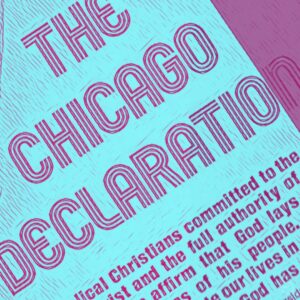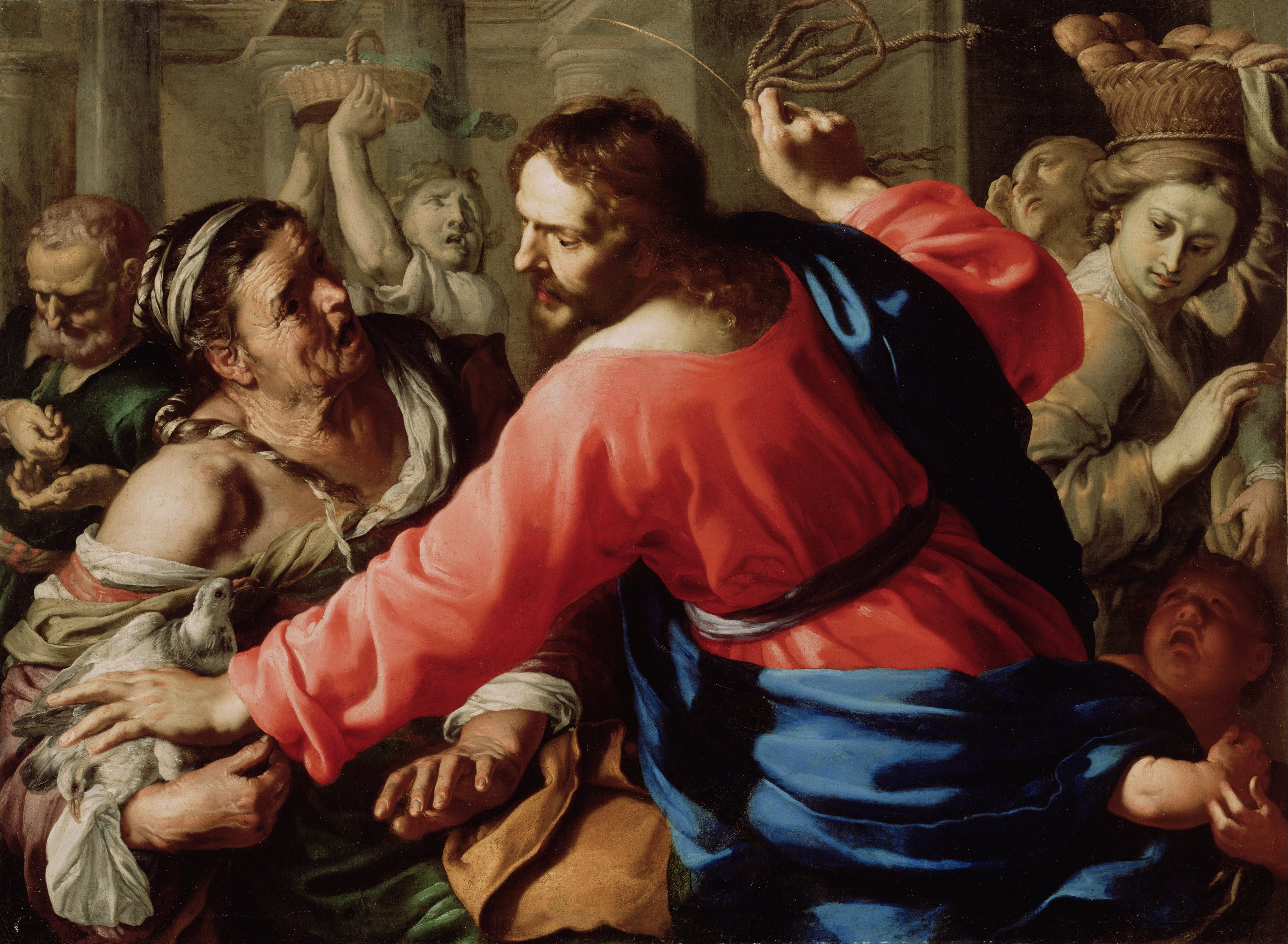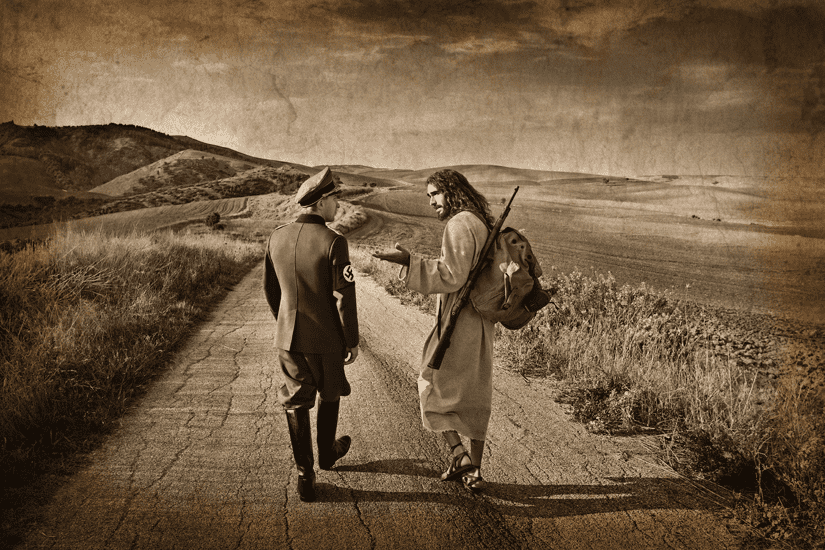 Mahatma Gandhi considered Jesus the most active person of nonviolence in the history of the world. He was dismayed, however, that so few Christians understood or embraced Jesus’ nonviolence.
Mahatma Gandhi considered Jesus the most active person of nonviolence in the history of the world. He was dismayed, however, that so few Christians understood or embraced Jesus’ nonviolence.
Martin Luther King, Jr. considered the Hindu Gandhi the best modern disciple of the nonviolent Jesus, because Gandhi so spectacularly adhered to his teachings on the subject, applying them even to the national and international levels, perhaps for the first time.
Both Gandhi and King insisted that everything Jesus did was nonviolent, that his teachings comprised a veritable catechism of nonviolence, and that the way he faced his execution was the epitome of nonviolence. If we want to follow him, they taught, we too must be nonviolent.
When I speak to church congregations about the nonviolent Jesus, the question inevitably arises, “Yes, but didn’t Jesus overturn tables and chase people out of the temple with a whip? Isn’t that violent?” Many remember El Greco’s unhelpful painting Christ Cleansing the Temple, where Jesus raises his arm high into the air, his hand grasping a long whip, ready to strike a group of people, including terrified women.

In each instance, I find myself saying that El Greco was wrong. Jesus did not use violence. He never hurt anyone. He never struck anyone. He never killed anyone. He did not tolerate injustice, greed, hypocrisy, or untruth. He confronted systemic injustice head on, as his disciples Dorothy Day and Martin Luther King, Jr. would later do. He gave his life for God’s reign of justice and peace, but he always did so through meticulous nonviolence.
Our problem is that the nonviolent Jesus was decidedly not passive. He did not sit under a tree and practice his breathing. He walked regularly into the face of danger, spoke the truth, and demanded justice. As far as decent, law-abiding, religious people were concerned, he was nothing but trouble. He hung out with the wrong people, healed at the wrong time, visited the wrong places, and said the wrong things. His nonviolence was active, provocative, public, daring, and dangerous.
Many of Jesus’ actions were illegal. He frequently committed civil disobedience.
That’s why I’ve begun to think of him as a one-man crime wave walking through the Roman Empire, beginning the process of disarmament wherever he went. The story has become so warped for the benefit of the ruling elite that we forget that Jesus was executed by the empire as a terrorist. Indeed, he was a revolutionary, but a nonviolent revolutionary.
As far as I can tell, only four events appear in all four gospels: the multiplication of the loaves and fishes; his street theater entrance into Jerusalem; his dramatic civil disobedience in the temple; and his execution on the cross. (The risen Jesus does not appear in Mark’s gospel; we only hear of an empty tomb.)
Mark, Matthew, and Luke present the same basic storyline. Jesus organizes the poor and disenfranchised in Galilee. Then he turns, sets his face to Jerusalem, and starts a walking campaign of nonviolence right into the temple, where he engages in peaceful civil disobedience. For this he is arrested, tried, tortured, and executed.
The Synoptic Gospels tell how Jesus turns over the tables of the money-changers and the seats of those who were selling doves, and drives out those selling and buying. Mark says he did not permit anyone to carry anything through the temple area. Then he started to teach the crowds. “Is it not written,” he asks in Mark, “‘My house shall be called a house of prayer for all peoples’? But you have made it a den of thieves” (11:17).
There is no mention of a whip, no talk of violence, no report of anyone being hurt. The whole event probably lasted five minutes. It would have stunned the crowds, who apparently stayed to hear his message. As anyone who has engaged in nonviolent civil disobedience knows, this was a classic example of symbolic, nonviolent direct action.
And it needed to be done. The Temple Mount in Jerusalem, built by Herod Antipas at the beginning of the century, was held up as the one and only place where God dwelt. We have nothing quite like it today. It combined worship, commerce, local government, execution site, and imperial control. It would resemble some massive building in Washington, DC, containing the Pentagon, the US Capitol, the White House, Wall Street, the World Bank, Citibank, Goldman Sachs, Walmart, the National Cathedral, and the Shrine of the Immaculate Conception—all rolled into one as God’s home on earth.
The faithful were expected to pay God a visit in the temple each year, so every Passover they made the long trek to Jerusalem and paid a hefty fee to enter God’s sanctuary. The population tripled to over 180,000. Over 18,000 animals would be purchased and slaughtered for holy sacrifice in the temple. A heavy tax was charged for all of this commerce. In effect, the temple housed a national bank, hawked loans, tracked debts, and changed money for unclean sinners so they could pay with “holy” temple money. Special fees were added for this money changing. Women, poor people, and other outcasts had to purchase expensive doves so that they could be “purified” to offer worship. The various fees robbed the poor and did so in God’s name under the watchful, greedy eye of the Roman Empire.
Anyone who cared about justice or read the prophets would be outraged at such institutionalized injustice. It was only natural that Jesus took action to protest this huge corporate, imperial, religious rip-off.
As commentators note, Jesus did not merely want lower prices for the poor. He did not seek to reform the temple. Through his symbolic action, he called for an end to the entire temple system. He taught a new, authentic worship of the living God. In Mark, Jesus urges his disciples to live in faith, pray all the time, and forgive those who have hurt them every time they pray. This simple plan was Jesus’ spiritual practice for a new world beyond the temple cult. With this action, he announced that God was present within every person; present whenever two or three gathered to pray in his name; present in the hungry, sick, or imprisoned; present in the breaking of the bread and the passing of the cup; present in Spirit and in Truth.
Jesus’ action and those teachings threatened and outraged the religious authorities. Their economic and political privilege would end if his teachings were adopted, so they had him killed.
Certainly, Jesus’ action in the temple is the boldest political event in the entire Bible. And, it has been duly ignored and misunderstood for 2,000 years. Mark’s version (11:11–26) notes that Jesus first entered the temple, looked around, left, returned the next day, and then took action. Only those who have undertaken civil disobedience with a steadfast commitment to nonviolence could understand that sentence: Jesus was casing the joint! He wanted to see for himself what was happening, plan his action, pray over it, and be perfectly nonviolent.
Jesus did not turn over the tables in an outburst of anger. His act was premeditated nonviolence following his initial reconnaissance.
As one who has been arrested many times for acts of nonviolent civil disobedience, I understand that need to prepare oneself thoroughly if one intends to be nonviolent. This detail from Mark, for me, proves the nonviolence of Jesus in the temple.
The only mention of a “rope” or a “whip” is in John’s gospel, written 20 to 40 years after the Synoptics. Throughout John’s gospel, like the others, Jesus is perfectly nonviolent. Indeed, he speaks more often here than in the other gospels about nonviolent love—agape—the Greek word for “unconditional, non-retaliatory, universal, sacrificial love.” It’s in John that Jesus announces the heart of nonviolence—“No one has greater love [agape] than this, to lay down one’s life for one’s friends.”
John’s story begins with the miraculous changing of water into wine during the wedding at Cana, a sign that all ritual, religious cleansings are now abolished and God’s reign, an eternal wedding banquet of agape, has begun. Jesus then suddenly appears in Jerusalem during the Passover feast to continue this work of abolishing the religious cult. He enters the temple area, “makes a whip of cords,” and drives out the oxen, sheep, doves, and everyone else.
He found in the temple area those who sold oxen, sheep and doves, as well as the moneychangers seated there. He made a whip of cords and drove them all out of the temple area, with the sheep and oxen, spilled the coins of the money-changers and overturned their tables, and to those who sold doves, he said, “Take these out of here and stop making my Father’s house a marketplace.” His disciples recalled the words of Scripture, “Zeal for your house will consume me.” At this the Judeans answered and said to him, “What sign can you show us for doing this?” Jesus answered and said to them, “Destroy this temple and in three days, I will raise it up.” The Judeans said, “This temple has been under construction for 46 years, and you will raise it up in three days?” But he was speaking about the temple of his body. Therefore, when he was raised from the dead, his disciples remembered that he had said this, and they came to believe the Scriptures and the word Jesus had spoken. (John 2:14–22) Most scholars agree that John deliberately paints Jesus as a righteous prophet in the tradition of Jeremiah, who engaged in similar dramatic actions. John’s readers would immediately recognize Jesus as a great prophet who comes directly out of the prophetic tradition.
My Scripture professor, Rev. John Boyle, S.J. at the Jesuit School of Theology in Berkeley, Calif., told us that this reference to a “rope” or a “whip” was the only instance in the entire Bible for that particular obscure Greek word. To get thousands of sheep, oxen, and doves into this enormous structure, my professor explained, cattlemen and shepherds used cords and ropes to lead animals up the high stone walkways into the building. Jesus simply took those cords, which the cattle, sheep, and oxen would have recognized, and started to drive them outside. Then he overturned the bankers’ tables and launched into his speech.
But didn’t he take a rope or a whip and start striking people? Some translations would have you believe so, but that would be entirely inconsistent with the Jesus portrayed throughout John’s gospel, as well as the Synoptics. Jesus was nonviolent from Cana to the cross and back to Galilee—but he was a bold revolutionary. With such spectacular nonviolence, one cannot imagine Jesus even striking the poor animals. Indeed, he was liberating them from their impending execution!
Misinterpretation of this one word has been used to justify countless massacres, crusades, wars, and even the US nuclear annihilations of Hiroshima and Nagasaki.
Perhaps we want Jesus to have some trace of violence in order to justify our own violence. We desperately hope he was violent so that we can dismiss his teachings, wage war, and build nuclear weapons without any guilt.
The key lies in John’s punch line: “Destroy this temple and I will raise it up in three days” (2:19). John’s version has a completely different agenda. For John, Jesus is the new temple, and it will rise. The focus is on Jesus’ resurrection. If the climactic action of Jesus’ life, in John’s testimony, is the raising of Lazarus, then Jesus’ allusion to resurrection here at the start makes sense. As I wrote in my book Lazarus, Come Forth!, Lazarus represents the entire human race, which Jesus calls out of the culture of war, empire, and death into the new life of resurrection. With this prophetic action in the temple, Jesus points to himself right from the start as “the Resurrection.”
Later, during his arrest, trial, torture, and execution, Jesus remains nonviolent. He forgave his killers and surrendered himself into the hands of his beloved Father. His nonviolence cannot be doubted, I submit, if we read through these shocking passion accounts. He displays no trace of violence, vengeance, retaliation, or even anger.
With this in mind, I think we are asking the wrong question. The real question is, “What does Jesus’ dramatic, illegal, nonviolent direct action against systemic injustice mean for us, his followers? If Jesus gave his life to confront temple injustice, what would he want his followers to do today in the face of the Pentagon, Los Alamos, the School of the Americas, or other US military institutions?”

I think Jesus expects his followers to undertake similar bold, nonviolent action.
He would want us to go to our own Jerusalems, turn over the tables of injustice, and speak out for justice and peace. Not only would he expect us to be people of contemplative prayer, he would insist that we be people of creative nonviolence who resist injustice and work for God’s reign of peace, come what may.
That is why followers and admirers of Jesus have undertaken similar campaigns of active nonviolence and civil disobedience. Mahatma Gandhi marched to the sea, picked up the illegal salt, and announced India’s revolution. Dr. King marched illegally in downtown Birmingham on Good Friday, 1963, to bring down the evil US segregation laws. Dorothy Day was repeatedly arrested in the early 1960s for refusing to go underground during New York City’s nuclear air raid drills. Daniel and Philip Berrigan and seven others entered the Catonsville, Maryland, draft center in May, 1968, took hundreds of A-1 draft piles, dumped them in the parking lot, and burned them with homemade napalm to protest the US war in Vietnam. Such nonviolent actions continued Jesus’ campaign of nonviolent civil disobedience. All of these peacemakers were misunderstood and accused of being violent, just as Jesus was, even though they practiced meticulous nonviolence whenever they acted publicly.
Because of Jesus’ nonviolent civil disobedience in the temple, I have engaged in civil disobedience actions and have been arrested over 75 times at US military and nuclear bases around the nation. In my first arrest, in April 1984, I sat down in the doorway of the riverside entrance to the Pentagon. My sit-in lasted only a few minutes. I hit no one and yelled at no one. I was quickly surrounded by a dozen armed policemen and soldiers and then arrested. (Later, a judge found me guilty but refused to put me in prison.) Still, hundreds of people gathered to watch me. One could say that, like Jesus, I prevented people from coming and going. It was a peaceful, prayerful, symbolic act. As I later told the judge, I was just trying to follow the nonviolent, civilly disobedient Jesus.
The gospels portray Jesus of Nazareth as the most active person of nonviolence in the history of the world.
He taught a glorious vision of nonviolence: “Love your enemies. Blessed are the peacemakers. Put down your sword. Be as compassionate as God. Hunger and thirst for justice. Seek first God’s reign and God’s justice.” As his followers, we are forbidden to support war, killings, executions, nuclear weapons, corporate greed, environmental destruction, or violence of any kind. More, we are sent into the culture of violence and war on a mission of prophetic peacemaking and active nonviolent resistance to evil.
If we want to follow this daring, nonviolent Jesus, I suggest that we confront our own unjust institutions, even to the point of nonviolent civil disobedience, in pursuit of God’s reign of justice and peace. We too may be misunderstood and persecuted, even arrested and jailed. But if we can maintain the steadfast nonviolent love of Jesus, then God’s reign will break through again, and we will herald the coming of a new world without war, poverty, injustice, or nuclear weapons, a whole new world of loving nonviolence. Then, we will have learned a faith, one not worth killing for, but worth living for.
***
This article was adapted from Chapter 12 of A Faith Not Worth Fighting For: Addressing Commonly Asked Questions about Christian Nonviolence, edited by Tripp York and Justin Bronson Barringer (Cascade Books, 2012). It is reproduced here by kind permission of the publisher. This essay first appeared here on Dec 4, 2017.
This essay is the fifth and final installation in our Chicago Declaration Series which celebrates the 50th anniversary of CSA’s founding document, the Chicago Declaration of Evangelical Social Concern. The Chicago Declaration, signed by 53 Evangelical leaders in 1973, was written as a call for Christians to engage in issues of justice and to reject racism, economic injustice, violence, and sexism. This month, we highlight essays and conversations on these justice issues in remembrance and celebration of the importance of CSA’s founding document.
See our other posts in this series: The Importance of the Chicago Declaration, Reflections on Faithful Anti-Racism, Does Jesus Want You to be Poor? and 4 Ways to Reject Gender-Based Domination of Women.
***
John Dear, SJ, is a Jesuit priest, peace activist, organizer, lecturer, and retreat leader. He is also the author/editor of twenty books on peace and nonviolence, and was nominated for the Nobel Peace Prize by Archbishop Desmond Tutu.


2 Responses
Dear John,
Jesus is not exhibiting civil disobedience, He is doing the will of the Father. Pilate and the Romans were very unaware of Jesus until the end. Jesus never says anything detrimental to the Romans. He mentions Pilate once, when he says that the men whose blood Pilate mingled with their sacrifices were not worse sinners than anyone else. He mentions Caesar once, saying to “render to Caesar the things that belong to Caesar.” He heals a centurian’s servant. Pilate finds no cause to crucify Jesus, but only does so when the Sanhedrin will not relent.
Jesus does have strong words of rebuke for the spiritual leaders of the people. The Sanhedrin cannot legally arrest Him because He does not break the law, but He does break tradition. When He takes the cords and chases (not beats or whips) the money-changers and merchants off the temple grounds, He is not breaking, but enforcing Jewish law; the priests and elders don’t arrest Him, because He has exposed their hypocrisy in this matter. This is a seemingly violent act, but there is no real violence in it. He doesn’t incite violence by this act of rebuke.
Jesus has not come to bring physical violence. The only violence He brings is His own sacrifice on the cross. When Peter tries to defend Jesus with a weapon, Jesus commands him to put his weapon away. “Those who live by the weapon will perish by the weapon.” Jesus and the apostles never tell us to do anything violent or make a physical defense, but on the contrary, they tell us to be willing to suffer and die for righteousness sake. We pray for God to help us endure.
Those of us who seek to follow Christ, seek to affect people’s hearts to follow Christ also. We pray the Holy Spirit will move in people’s hearts, yet we know all are not willing to open their hearts. Whatever changes we can bring to people and communities through peaceful, kind, gentle, joyful, and loving actions, we should do. When we see others being harassed, persecuted, hated, despised, demeaned, blamed, oppressed, shut-out, chased away, beaten, stabbed, shot, enslaved, raped, abused, excluded, we should stand with and for them. When we see others who exhibit hatred and bitterness, and selfishness, and fear, then we must speak the truth in love, as Jesus loves.
At its least, non-violence seeks to make changes through peaceful means, “turning the other cheek.” At it’s best, it should seek to move people’s hearts, oppressed and oppressor, hated and hateful, to do as Christ commands us.
We all need Jesus Christ. I am reminded daily that I do.
Dear Jphn,
Mother Teresa said the biggest obstacle to world peace was abortion. Have you also been arrested blocking the entrance to an abortion clinic?